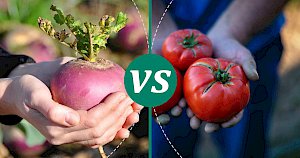Tomato vs Turnip: Nutrition, Calories & Protein Compared


Tomato vs Turnip
Nutrition Facts
Serving size:
change
5g10g15g20g30g40g50g60g80g100g120g140g160g180g200g220g250g300g350g400g450g500g600g700g800g900g1000g
1oz2oz3oz4oz5oz6oz7oz8oz10oz12oz15oz20oz25oz30oz35oz40oz50oz
Amount Per Serving:
Serving size:
change
5g10g15g20g30g40g50g60g80g100g120g140g160g180g200g220g250g300g350g400g450g500g600g700g800g900g1000g
1oz2oz3oz4oz5oz6oz7oz8oz10oz12oz15oz20oz25oz30oz35oz40oz50oz
Amount Per Serving:
Tomato vs Turnip 100g Compare
| per 100g | Tomato | Turnip |
|---|---|---|
| Calories | 18 | 28 |
| Carbohydrates | 3.9 g | 6.43 g |
| Fat | 0.2 g | 0.1 g |
| Dietary fiber | 1.2 g | 1.8 g |
| Protein | 0.9 g | 0.9 g |
| Calcium | 10 mg | 30 mg |
| Iron | 0.3 mg | 0.3 mg |
| Magnessium | 11 mg | 11 mg |
| Potassium | 237 mg | 233 mg |
| Sodium | 5 mg | 39 mg |
| Zink | 0.17 mg | 0.27 mg |
| Vitaminium B1 (Thiamine) | 0.037 mg | 0.04 mg |
| Vitaminium B3 (Niacin) | 0.594 mg | 0.4 mg |
| Vitaminium B6 | 0.08 mg | 0.09 mg |
| Vitaminium B9 (Folic acid) | 15 mg | 15 mg |
| Vitaminium C | 13 mg | 21 mg |
| Vitaminium E | 0.54 mg | 0.03 mg |
| Vitaminium K | 7.9 µg | 0.1 µg |
Discovering the Nutritional Gems: Tomato and Turnip
When it comes to enriching our diet with vegetables, tomatoes and turnips are two vibrant contenders that often spark curiosity among health enthusiasts. Beyond their colorful appeal and distinct flavors, these vegetables hold a treasure trove of nutrients, making them worthy of a closer look. Whether you're a culinary expert or someone simply looking to enhance your dietary choices, understanding the nutritional profile and benefits of tomatoes and turnips can lead to more informed decisions for your meals.
Tomatoes: A Juicy Powerhouse of Nutrients
Tomatoes are not only a staple in kitchens around the world for their versatility but also celebrated for their impressive nutritional content. They are particularly known for their high vitamin C and beta-carotene levels, which contribute to their bright red color. With only 18 calories per 100 grams, tomatoes offer a low-calorie option for those monitoring their intake. They contain 3.9 grams of carbohydrates and 1.2 grams of dietary fiber, supporting healthy digestion and providing a feeling of fullness. Additionally, tomatoes are a good source of vitamin A (833 IU), vital for vision and immune function, and vitamin E (0.54 mg), which acts as an antioxidant.
Turnips: The Underrated Root with Mighty Nutrients
Turnips, often overlooked, are a root vegetable with a mildly spicy flavor that can enhance a variety of dishes. They are slightly higher in calories than tomatoes, with 28 calories per 100 grams, but still remain a low-calorie choice. Turnips boast a higher content of 6.43 grams of carbohydrates and 1.8 grams of dietary fiber, making them a great option for maintaining a healthy gut. Remarkably, turnips provide a good dose of vitamin C (21 mg), crucial for immune health and skin integrity. They also contain 30 mg of calcium per 100 grams, supporting bone health.
Nutritional Face-Off: Tomato vs. Turnip
When comparing the two, it's clear that both tomatoes and turnips have their unique nutritional offerings. Tomatoes stand out for their vitamin A and E content, which are essential for maintaining healthy vision, skin, and immune function. On the other hand, turnips provide a slightly higher amount of dietary fiber and vitamin C, which are key for digestive health and immunity.
- Calories: Tomatoes are lower in calories, making them ideal for weight management.
- Carbohydrates and Fiber: Turnips contain more carbohydrates and fiber, which may be beneficial for those looking to increase their intake.
- Vitamins: Tomatoes are rich in vitamin A and E, while turnips offer more vitamin C and calcium.
Choosing between tomatoes and turnips doesn't have to be an either/or decision. Incorporating both into your diet can provide a wide range of nutrients that benefit your health in different ways. Whether it's a fresh tomato salad or a hearty turnip stew, these vegetables can add flavor, color, and nutrition to your meals.
Embracing Variety for Optimal Health
In the end, the choice between tomatoes and turnips may come down to personal preference or specific dietary needs. What's most important is recognizing the value of variety in our diet. By exploring different vegetables and their nutritional profiles, we can enjoy a richer, more balanced diet that supports our overall health and well-being.
So, the next time you're at the grocery store, consider picking up both tomatoes and turnips. Experiment with recipes and enjoy the unique flavors and health benefits each has to offer. After all, variety is the spice of life, and when it comes to nutrition, it's also the foundation of good health.
Tomato 100g
18kcalCalories source
- 74% CARBS.
- 17% PROTEIN
- 9% FAT
Turnip 100g
28kcalCalories source
- 85% CARBS
- 12% PROTEIN
- 3% FAT
Compares of tomato
- Tomato vs Arugula
- Tomato vs Beetroot
- Tomato vs Pepper
- Tomato vs Bitter Melon
- Tomato vs Broccoli
- Tomato vs Brussels Sprouts
- see all compares of tomato
Marcin Piotrowicz
calories-info.com creator
Healthy diet and healthy lifestyle promoter
Add comment